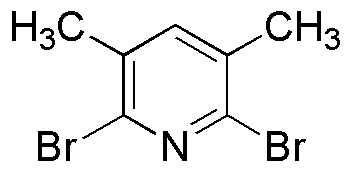2,6-Dibromo-3,5-dimethylpyridine is widely utilized in research focused on:
- Agricultural Chemistry: This compound serves as a key intermediate in the synthesis of agrochemicals, particularly herbicides and fungicides, helping to enhance crop protection and yield.
- Pharmaceutical Development: It is used in the synthesis of various pharmaceuticals, offering potential therapeutic benefits in treating conditions such as infections and inflammation.
- Material Science: The compound is employed in the development of specialty polymers and coatings, providing improved durability and resistance to environmental degradation.
- Analytical Chemistry: It acts as a reagent in analytical methods, aiding in the detection and quantification of other chemical substances in complex mixtures.
- Research and Development: This chemical is a valuable tool for researchers exploring new chemical reactions and pathways, facilitating advancements in organic synthesis.
General Information
Properties
Safety and Regulations
Applications
2,6-Dibromo-3,5-dimethylpyridine is widely utilized in research focused on:
- Agricultural Chemistry: This compound serves as a key intermediate in the synthesis of agrochemicals, particularly herbicides and fungicides, helping to enhance crop protection and yield.
- Pharmaceutical Development: It is used in the synthesis of various pharmaceuticals, offering potential therapeutic benefits in treating conditions such as infections and inflammation.
- Material Science: The compound is employed in the development of specialty polymers and coatings, providing improved durability and resistance to environmental degradation.
- Analytical Chemistry: It acts as a reagent in analytical methods, aiding in the detection and quantification of other chemical substances in complex mixtures.
- Research and Development: This chemical is a valuable tool for researchers exploring new chemical reactions and pathways, facilitating advancements in organic synthesis.
Documents
Safety Data Sheets (SDS)
The SDS provides comprehensive safety information on handling, storage, and disposal of the product.
Product Specification (PS)
The PS provides a comprehensive breakdown of the product’s properties, including chemical composition, physical state, purity, and storage requirements. It also details acceptable quality ranges and the product's intended applications.
Certificates of Analysis (COA)
Search for Certificates of Analysis (COA) by entering the products Lot Number. Lot and Batch Numbers can be found on a product’s label following the words ‘Lot’ or ‘Batch’.
Numéro de catalogue
Numéro de lot/série
Certificates Of Origin (COO)
This COO confirms the country where the product was manufactured, and also details the materials and components used in it and whether it is derived from natural, synthetic, or other specific sources. This certificate may be required for customs, trade, and regulatory compliance.
Numéro de catalogue
Numéro de lot/série
Safety Data Sheets (SDS)
The SDS provides comprehensive safety information on handling, storage, and disposal of the product.
DownloadProduct Specification (PS)
The PS provides a comprehensive breakdown of the product’s properties, including chemical composition, physical state, purity, and storage requirements. It also details acceptable quality ranges and the product's intended applications.
DownloadCertificates of Analysis (COA)
Search for Certificates of Analysis (COA) by entering the products Lot Number. Lot and Batch Numbers can be found on a product’s label following the words ‘Lot’ or ‘Batch’.
Numéro de catalogue
Numéro de lot/série
Certificates Of Origin (COO)
This COO confirms the country where the product was manufactured, and also details the materials and components used in it and whether it is derived from natural, synthetic, or other specific sources. This certificate may be required for customs, trade, and regulatory compliance.


